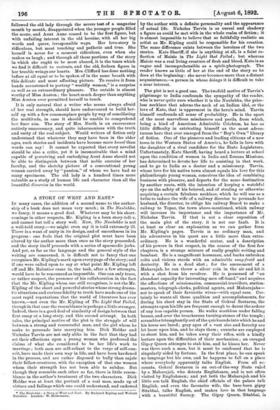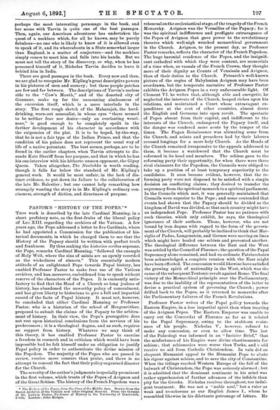A STORY OF WEST AND EAST.*
Ix many cases, the addition of a second name to the author- ship of a book does not mean very much ; in The Naulahka, we fancy, it means a good deal. Whatever may be his short- comings in other respects, Mr. Kipling is a born story-teller, and cannot but tell a story well. Now, The Naulahka is not a well-told story,—we might even say it is told extremely ill. There is a want of unity in its design, and of smoothness in its progress : one feels that the original plot must have been altered by the author more than once as the story proceeded, and the story itself proceeds with a series of spasmodic jerks. And yet, as far as the language and the general style of the writing are concerned, it is difficult not to fancy that one recognises Mr. Kipling's mark upon everypage of the story; and if one were called upon to say at what point Mr. Kipling left off and Mr. Balestier came in, the task, after a few attempts, would have to be renounced as impossible. One can only trace, or rather suspect, the presence of his collaboration in the fact that the Mr. Kipling whom one still recognises, is not the Mr. Kipling of the short and powerful stories whose strong drama- tic situations and curious fidelity to truth have made one of the most rapid reputations that the world of literature has ever known,—not even the Mr. Kipling of The Light that Failed, though in that case the resemblance is perhaps a little stronger. Indeed, there is a good deal of similarity of design between that first essay at a long story, and this second attempt. In both tales, the principal motive of the plot is the struggle of will between a strong and resourceful man, and the girl whom he seeks to persuade into marrying him. Dick Heldar and Nicholas Tarvin are not only alike in the fact that they had set their affections upon a young woman who preferred the claims of what she considered to be her life's work to marriage ; both men are self-reliant to the verge of self-con- ceit, have made their own way in life, and have been hardened In the process, and are rather disposed to bully than cajole their fellow-creatures, with the exception of that one woman whom their strength has not been able to subdue. But though they resemble each other so far, there is little resem- blance in the author's treatment of the two characters. Dick Heldar was at least the portrait of a real man, made up of virtues and failings which one could understand, and endowed • The NaulnIska a Story of West and Bast. By Hndyard Kipling and Wolcott Baleatier. London : W. Heinemann. by the author with a definite personality and the appearance of actual life. Nicholas Tarvin is as unreal and shadowy a figure as could be met with in the whole realm of fiction ; it is almost impossible to believe that so faithfully realistic an artist as Mr. Kipling could be responsible for his creation. The same difference exists between the heroines of the two stories. Kate Sheriff, if she is anything at all, is a faint re- flection of Maisie in The Light that Failed ; but whereas Maisie was a real living creature of flesh and blood, Kate is as vague and incomprehensible as a spirit-photograph. The reader knows as little of her at the end of the story as he does at the beginning : she never becomes more than a distant acquaintance,—a person in whose doings it is difficult to take a near interest.
The plot is not a good one. The twofold motive of Tarvin's pilgrimage to India confounds the sympathy of the reader, who is never quite sure whether it is the Nanlahka, the price- less necklace that adorns the neck of an Indian idol, or the love of Kate, that is uppermost in the hero's mind. Tarvin himself confounds all sense of probability. He is the sport of the most marvellous mischances and perils, from which, being a kind of American Admirable Crichton, he has as little difficulty in extricating himself as the most adven- turous hero that ever emerged from the "Boy's Own" library of fiction. One of the pioneers and leading citizens of a new town in the Western States of America, he falls in love with the daughter of a rival candidate for the State Legislature. Unfortunately, Kate Sheriff, having heard a lecture at school upon the condition of women in India and Zenana Missions, has determined to devote her life to assisting in that 'work, and to go to India as a doctor and a missionary. Tarvin, whose love for his native town almost equals his love for this philanthropic young woman, conceives the idea of combining business with pleasure, and departs for the same destination by another route, with the intention of keeping a watchful eye on the safety of his beloved, and of stealing or otherwise acquiring a certain fabulous necklace, which he will use as a bribe to induce the wife of a railway director to persuade her husband, the director, to oblige his railway Board to make a railway to Topaz, the town above-mentioned, which railway will increase its importance and the importance of Mr. Nicholas Tarvin. If that is not a clear exposition of the main plot of the story, it is not our fault. it is at least as clear an explanation as we can gather from Mr. Kipling's pages. Tarvin is no ordinary man, and his adventures in his quest are a little more than extra- ordinary. He is a wonderful orator, and a description of his powers in that respect, in the course of the first few chapters, is a strange mixture of really graphic writing and bombast. He is a magnificent horseman, and backs unbroken colts and vicious steeds with an admirable sang-froid and dexterity. He is a dead shot ; for the amusement of a Maharajah, he can throw a silver coin in the air and hit it with a shot from his revolver. He is possessed of "an abundant capacity for interesting men off-hand," and acquires the affections of missionaries, commercial-travellers, station- masters, telegraph-clerks, political agents, and Maharajahs— not to speak of their favourite wives—with equal ease. Cer- tainly he wants all these qualities and accomplishments, for during his short stay in the State of Gokral Seetaran, the attempts upon his life are frequent enough to daunt the ardour of any less capable person. He walks scathless under falling beams, and over the treacherous turning-stones of the temple ; scrambles triumphantly out of the quicksands into which he and his horse are lured ; grey apes of a vast size and erocity are let loose upon him, and be slays them ; eunuchs are employed to shoot him, and he takes away their rifles, with a kindly lecture upon the difficulties of their mechanism ; an enraged Gipsy Queen attempts to stab him, and he kisses her. Never was there such a man, but it must be confessed that he is singularly aided by fortune. In the first place, he can speak no language but his own, and he happens to fall on a place where everybody apparently talks English. From all ac- counts, Gokral Seetarun is an out-of-the-way State ruled by a Maharajah, who detests Englishmen, and is not often visited by Englishmen; and yet both the Maharajah and his little son talk English, the chief officials of the palace talk English, and even the favourite wife, the base-born gipsy Sitabhai, talks English, and makes love in that language with a beautiful fluency. The Gipsy Queen, Sitabhai, is
perhaps the most interesting personage in the book, and her scene with Tarvin is quite one of the best passages. 'Then, again, our American adventurer has undertaken the guest of a necklace which, for all he knows, may be purely fabulous—no one who is likely to know of it is allowed even to speak of it, and its whereabouts in a State somewhat larger than England, is a matter of conjecture—and the necklace simply comes to meet him and falls into his hands. But we must not tell the story of its discovery, or why, when he has possessed himself of it, Nicholas Tarvin decides to leave it behind him in India.
There are good passages in the book. Every now and then, we are glad to recognise Mr. Kipling's great descriptive powers in his pictures of men and scenery ; but these purple patches are few and far between. The descriptions of Tarvin's useless ride to the "Cow's Mouth," and of the deserted city of Gunnaur, make up for the unmeaning aimlessness of the excursion itself, which is a mere interlude in the story. The first rough sketch of the Maharajah, the hard- drinking, worn-out sensualist, in whose eyes "there seemed to be neither fear nor desire—only an everlasting weari- ness," is good enough to be completely spoilt in the further development of his character in accordance with the exigencies of the plot. It is to be hoped, by-the-way, that he is not a fair type of the Indian Prince, and that the condition of his palace does not represent the usual way of life of a native potentate. The best scenes, perhaps, are to be found in the earlier chapters, when Tarvin attempts to dis- suade Kate Sheriff from her purpose, and that in which he has his one interview with his hitherto unseen opponent, the Gipsy Queen. Taken altogether, The Naulahka is worth reading, though it falls far below the standard of Mr. Kipling's general work. It would be most unfair, in the lack of dis- tinct evidence, to put down its failure to the collaboration of the late Mr. Balestier ; but one cannot help remarking how strangely wanting the story is in Mr. Kipling's ordinary con- ciseness, strength of diction, and directness of purpose.



































 Previous page
Previous page